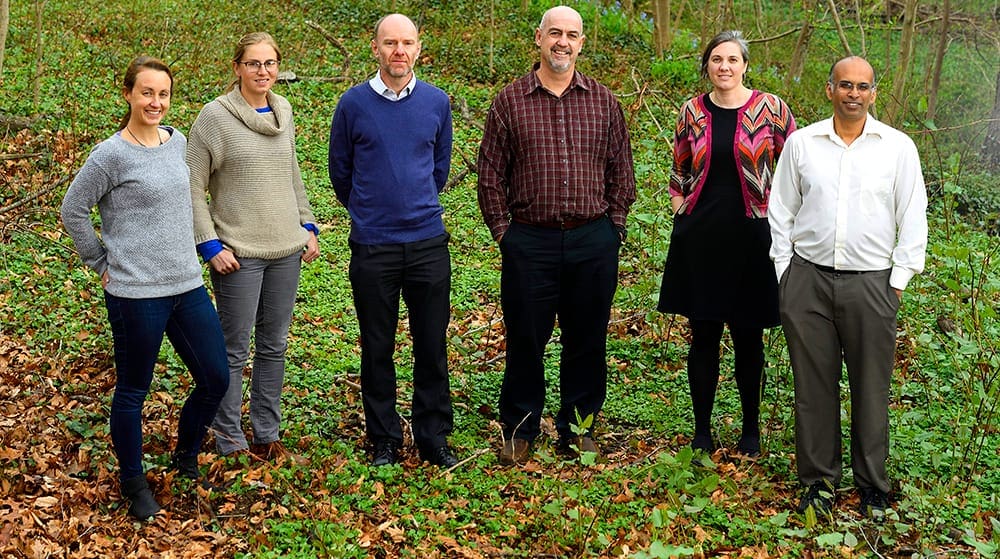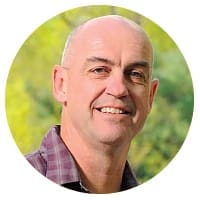
There are several things that scientists can say with certainty about climate change, notes Anand Gnanadesikan, professor in the Department of Earth and Planetary Sciences. We know, for instance, the mere presence of Earth’s atmosphere raises the average temperature of the planet. For proof, he points to the atmosphere-less moon, where surface temperatures average a chilly -60°F. On Earth, it is almost 100 degrees higher.
There is also the knowledge that certain gases—so-called greenhouse gases, like carbon dioxide—cause planets to warm. And, then, there is the inescapable truth that there is more carbon dioxide in our atmosphere today than at any time in known human history.
“These things are fact, not science fiction, not hypothesis,” he says. “The question now is what’s behind it, and what will be the consequences?”
Against that backdrop, Gnanadesikan is part of a cadre of Krieger School scientists who are tackling that question one piece at a time. Gnanadesikan says he looks at it as a three-part challenge: past, present, and future.
“It’s a multifaceted team that helps us paint a picture of where we’ve been, where we stand, and where we could be headed, environmentally speaking,” he says.
Past as Prologue: Maya Gomes
It begins with a baseline found in the past. To help answer those questions, there are the so-called “paleos”—Earth scientists, like assistant professors Maya Gomes and Emmy Smith, who peer back in time through the geological record to understand what went before, during other times when atmospheric carbon dioxide increased rapidly and, in contrast, how the flora and fauna of the time responded to those changes.
“I study chemicals preserved in rocks, and that allows me to understand something about how environmental conditions have changed in the past,” Gomes says.
Every time a rock forms at the bottom of the ocean it captures information about the time in which it formed. That record, set in stone as it were, is like a fingerprint—a shard of information that describes the conditions of the time.
Gomes is interested in the stories the chemicals tell about the major changes in the carbon cycle. High carbon dioxide, she says, produces ocean systems with low oxygen levels—anoxia, it is called.
“Animals, of course, need oxygen to live, so their choice is to migrate or die off,” Gomes explains. “There are these major periods in history with large, rapid increases in carbon dioxide, and we see that those are often associated with mass extinctions.”
Looking at carbon isotopes in the rocks—particularly the ratio of carbon 12 to carbon 13—and other geological evidence, Gomes can determine that a particular uptick in carbon dioxide millions of years ago was due to volcanic activity. Today, however, she says the isotopes in the atmosphere point in a decidedly different direction.
“The ratio of those two isotopes has been declining since the start of the industrial revolution, so the carbon we see today can only be from one source—the burning of fossil fuels,” Gomes says.
Forever Changes : Emmy Smith
Like Gomes, Emmy Smith is a field geologist—a “sedimentologist,” she says—who looks also at rocks that were once on the bottom of the sea. She is interested in the chemistry and biology of those times: the plants and animals, if there were any. For Smith, not just any stones will do. She needs sediments that preserve not just the chemical record, but the fossil record, as well.
“I don’t want them to be cooked and exposed to high pressures. I want them to have preserved some of these original fossil signatures,” Smith says. “There are only so many places like that around the world.”
Her work has taken her to locales such as Mongolia, China, South Africa, and Northwest Canada that have outcroppings of rock dating to a very specific time window in history known as the Neoproterozoic Era and Cambrian Period, roughly one billion to 500 million years ago. The Neoproterozoic was a time of great environmental upheaval. Toward the end of it, Earth was awakening from tens of millions of years covered almost entirely in ice. Oxygen was filling the atmosphere. There was an explosion of macroscopic life. The first animals appeared in this period.
“Often, these biotic shifts, the appearance of macroscopic life, the appearance of animals and so forth, they coincide with big environmental shifts,” Smith says. “But, are the environmental shifts driving the biotic ones, or vice versa?”
What science can say is that comparable times with high levels of carbon dioxide result in major changes in the types of life found on Earth.
“Climate change may not be an existential threat to humans, but one of the interesting things about Maya’s and Emmy’s work is that it asks the question of what would it take for human activities to have a similar impact to those past upheavals,” Gnanadesikan says.

Emmy Smith hiking in Southern Africa through ocean sediments that are approximately 550 million years old. [Photo courtesy of Emmy Smith]
Going with the Floe: Thomas Haine
If Gomes and Smith concern themselves with the ocean cycles of the past, Thomas Haine is all about the present. He is a physical oceanographer who runs massively complex computational models exploring, among other things, how seawater cycles through the Arctic then drains into the North Atlantic through the strait just to the east of Greenland. There the waters become part of the planetary circulatory pattern known as the ocean conveyor belt.
It is believed that climate change will cause the conveyor belt to slow, though the jury is still out, says Haine, the Morton K. Blaustein Chair and Professor. If true, however, then that slowing will lessen the ocean’s ability to moderate temperatures and restrict the transport of important nutrients from the deep ocean to the surface on which much ocean life depends.
Haine is particularly interested in freshwater that is trapped in the great flotilla of ice at the top of the world. When seawater turns to ice, only the water freezes, leaving the salt behind. As this sea ice melts each season, the relative amount of freshwater entering the seas has a profound impact on climate. Gradually, however, this mass of ice is getting smaller and thinner each September when it is at its lowest point of the year.
Haine believes we will see an ice-free North Pole during the summer months within the next decade or two. This transformation is happening before our eyes, in real time. Whether those changes have yet to manifest themselves in observable changes in the ocean currents remains an open question. The research is labor-intensive and expensive, slowing scientific progress.
“There’s not good evidence that the slowing of the ocean conveyor belt has happened so far,” Haine says, “but it might not be very long until we could say with confidence that it is. And, by that, I mean maybe the next five to ten years.”
Haine is less reserved when speaking about what is behind the seasonal decline in sea ice. He says there is no question that it is caused by human activities and, specifically, by the emission of greenhouse gases.
“The changes to sea ice in the last 40 years and in the freshwater cycle are very large,” Haine says, “It is, I think, the most conspicuous example of anthropogenic climate change we have right now.”
Polar Opposite: Darryn Waugh
Working on the other side of the world, literally, is Haine’s colleague, Professor Darryn Waugh. As an atmospheric scientist, Waugh has spent a significant amount of time looking at the activity of chlorofluorocarbons in aerosol spray cans and refrigerators, which were introduced in the 1930s. Chlorofluorocarbons (CFEs) are now being absorbed into the water. Like the carbon isotopes Gomes and Smith study, chlorofluorocarbons in the water are a chemical signature that reveal the secrets of the ocean conveyor belt.
“CFCs weren’t in the water until the 1930s, so the older water doesn’t have them and we can follow their trail to see how the currents are changing,” he says.
For many decades, CFCs were thought to be harmless. Eventually, however, scientists learned that chlorofluorocarbons in the atmosphere get split by UV radiation and the resulting chlorine destroys the protective ozone layer. The resulting ozone hole has important changes on the winds that circle Antarctica, and Waugh has recently extended his studies of these changing winds to their impacts on ocean currents as well.
The ozone hole is known to strengthen the winds circling Antarctica and, in turn, those winds roil the Southern Ocean, pushing surface waters downward and churning ancient waters from the deep to the surface. This overturning process enhances the ocean’s ability to moderate climate change by storing and transporting heat around the planet.
Waugh has compared the levels of one particular compound, CFC-12, in the waters of the Southern Ocean from early 1990s to the late 2000s, to show stronger winds caused by the ozone hole, indeed churn the seas, bringing deep water to the surface. While this may result in more heat being taken up by the ocean, it may also slow the ocean’s ability to absorb carbon dioxide.
Chlorofluorocarbons are acutely interesting to climate scientists like Waugh, because they have been banned since the 1990s. How they work their way out of the atmosphere will be interesting to watch.
“We’re not emitting CFCs anymore, that’s the good news, but it’s going to take a while for things to get removed from the atmosphere,” Waugh says. “We’ll be observing this over the next 30 years or more.”
The White Cliffs of Dover: Anand Gnanadesikan
The third piece of Gnanadesikan’s climate puzzle is to look to the future. His research takes him to the famous chalky white cliffs of Dover, where he says those cliffs fill in a small piece of the puzzle and offer a glimpse into the future of Earth.
Gnanadesikan does not study the cliffs per se, but rather, he examines coccolithophores, the tiny creatures that give those cliffs their memorable whiteness.
Coccolithophores are beautiful single-celled organisms that form a tough outer shell made of bone-white calcium carbonate, a mineral they extract from the seawater. It is the same mineral used to form the shells of countless sea creatures—from corals to clams to conchs. For eons, uncountable trillions of coccolithophore have lived and died and drifted to the bottom of the English Channel forming a thick, white seabed, layer upon layer, a half-millimeter each passing year.
Not long ago, Gnanadesikan and a group of colleagues, led by then-graduate student, Sara Rivero-Calle, who is now a postdoc at the University of Southern California, began to examine coccolithophores in the North Atlantic and found that they are thriving, increasing tenfold since 1965. The result surprised Gnanadesikan because greater carbon dioxide in the atmosphere is causing the oceans to become more acidic, and as a consequence, the thinking goes, sea creatures that build shells of calcium carbonate should suffer, not thrive.
“We think that by giving them more carbon dioxide, it makes them happy, even though the water is getting more acidic and their shells may dissolve,” he says.
Gnanadesikan’s finding is a microcosm of the monumental challenges inherent in understanding and predicting climate change. In science, that is just the way things go. Sometimes, research confirms expectations. Other times, it creates entirely new questions. It is part of what makes science exciting, he says.

A microscopic image of Coccolithophores [inset] found near England’s white cliffs of Dover [above].
Data in the DNA: Meghan Avolio
The newest member of the Department of Earth and Planetary Sciences, Assistant Professor Meghan Avolio, is a plant ecologist also looking to the future, though she prefers old-school field research to computer modeling.
“I work to simulate future climates and rainfall and try to understand how that will impact plants,” she says.
Avolio’s interest is in how plants will adapt to climate change over long periods of time. When not in Baltimore, she can often be found on a prairie in Northeast Kansas, one of the few remaining areas of native tallgrass prairie in the country. She researches a series of small, tented plots of land she calls rainfall manipulation plots, or RaMPS, for short.
The currency of her work is rainfall, where climate change is expected to produce winners and losers across the globe. Areas that are now arid, could become wetter. Areas that are tropical now, could become drier with potential impacts on ecology and industries, like agriculture.
Avolio studies the effect of varied rainfall on one particular species of tallgrass, the big bluestem. It is a complex thing to simulate. It is not just a matter of one region getting more or less rainfall than usual, but rather an increase in the variability of rainfall—fewer rainy days throughout the year, but larger amounts of rain.
Avolio has found that rain variability increases the genetic diversity in the big bluestem. Genetic diversity is generally considered a good thing in an ecological context. It improves resiliency of the plants to extreme conditions and betters the odds that some might endure worsening weather patterns.
“With increased climate variability, you have more niches for the plants to fill. The plants will naturally differentiate themselves to fill those niches,” Avolio says. “They become specialists adapted to the environmental conditions. We are seeing that happen right before our eyes.

As a Matter of Fact
Avolio’s work, at least, provides a little encouraging news in a world generally filled with dire predictions. As for what the future will hold, Gnanadesikan runs down the litany of facts as we know them—facts that are confirmed and illuminated by the work of his colleagues. We know the atmosphere is warming. We know greenhouse gases are the cause. We know that greenhouse gases are higher than any time in known history.
The world can debate the cause, Gnanadesikan says, but not the consequences. Time is running out.
Looking at past and present, he says, there is no doubt that increased carbon dioxide will cause significant increases in global temperatures, rising sea levels, shifts in rainfall, and river flow. It’s probable that it will cause greater extinctions and increase the intensity of torrential rains, within our lifetimes, he asserts.
“At the very least, I think global warming has the potential to be a serious inconvenience to society, but probably not an existential threat.” Gnanadesikan says, “However, if I’m wrong about that, I’d like to know about it sooner rather later. That’s why the science matters so much. You never know where the data will lead. You follow it where it goes.” ◾

Earth and Planetary Science professors featured in this article (l-r), Maya Gomes, Emmy Smith, Thomas Haine, Darryn Waugh, Meghan Avolio, and Anand Gnanadesikan.









